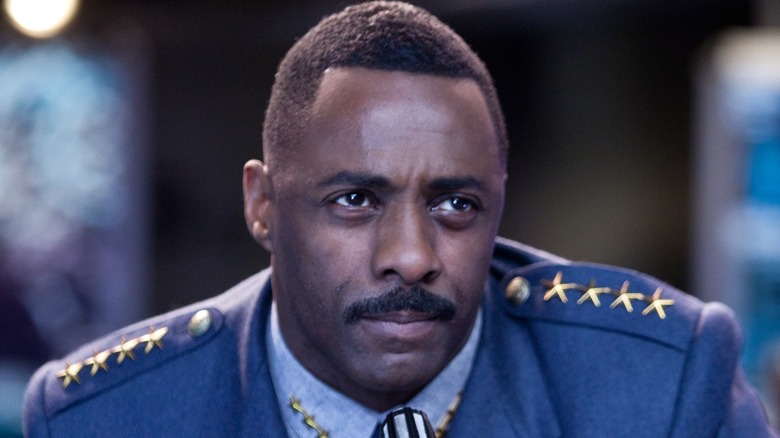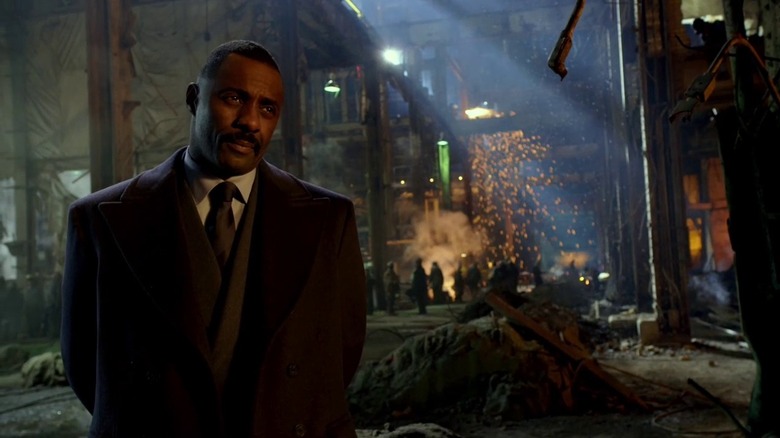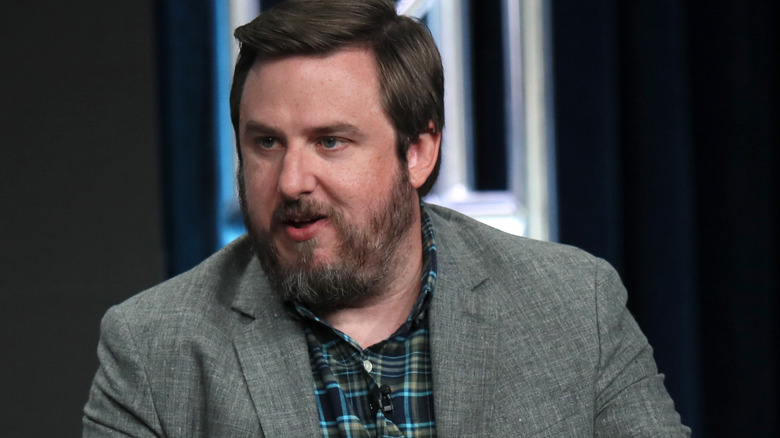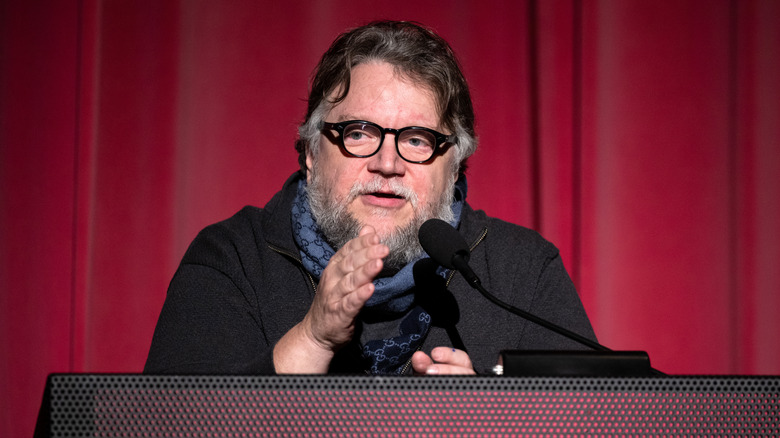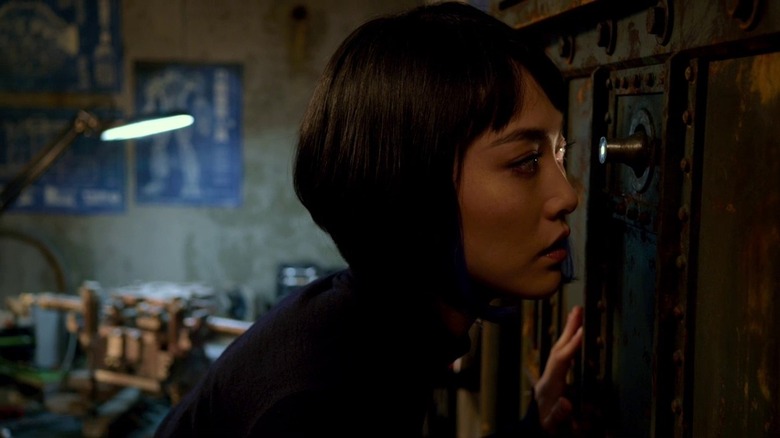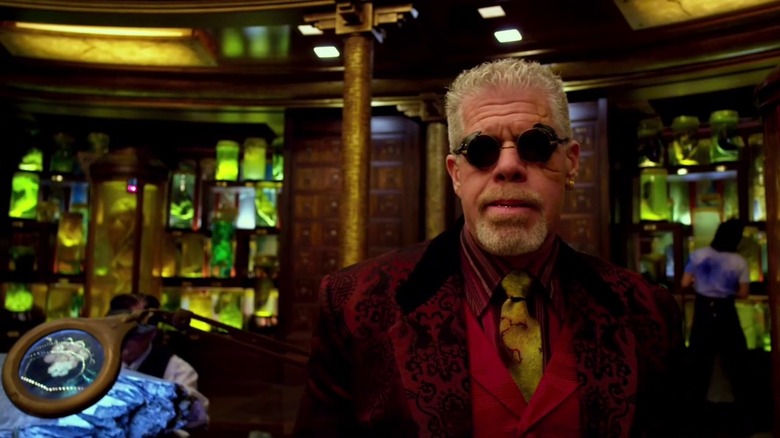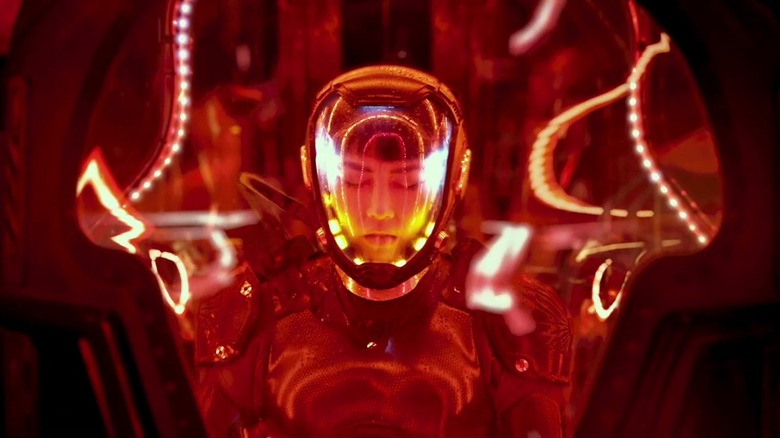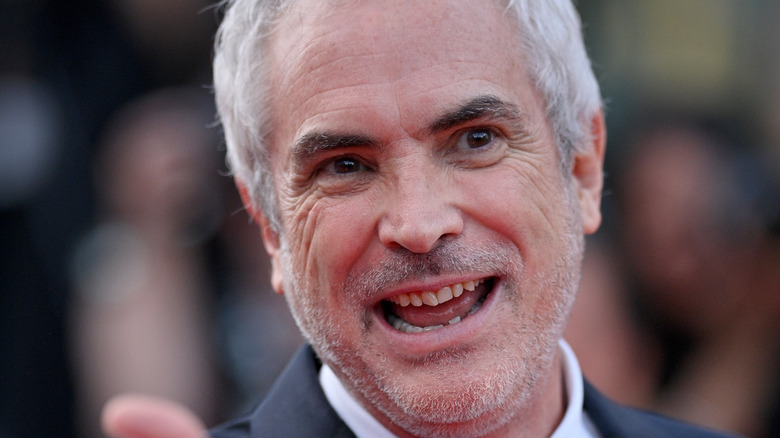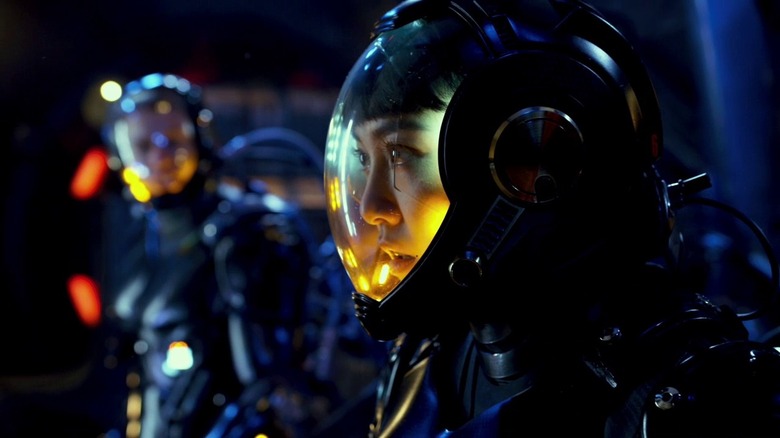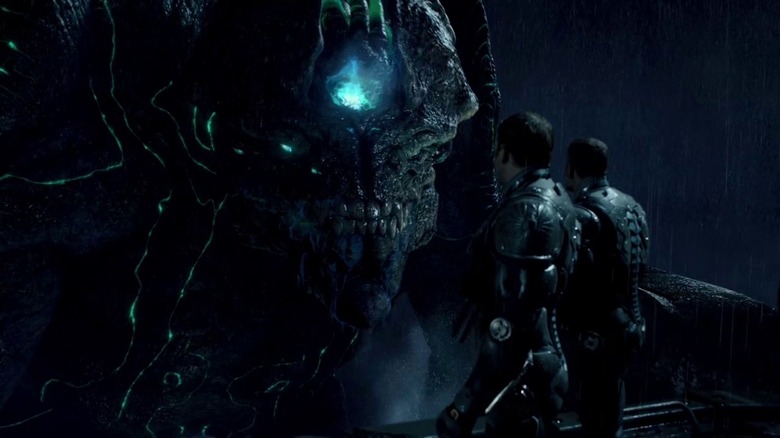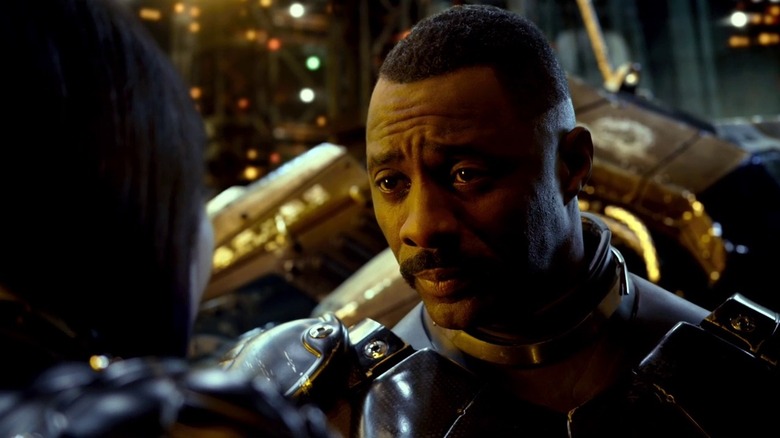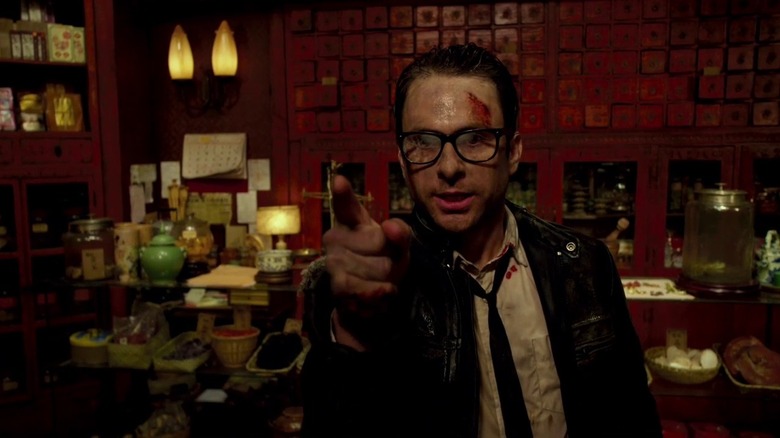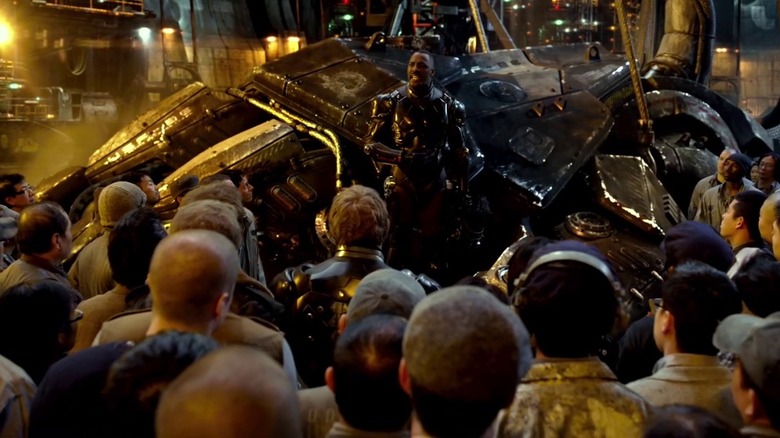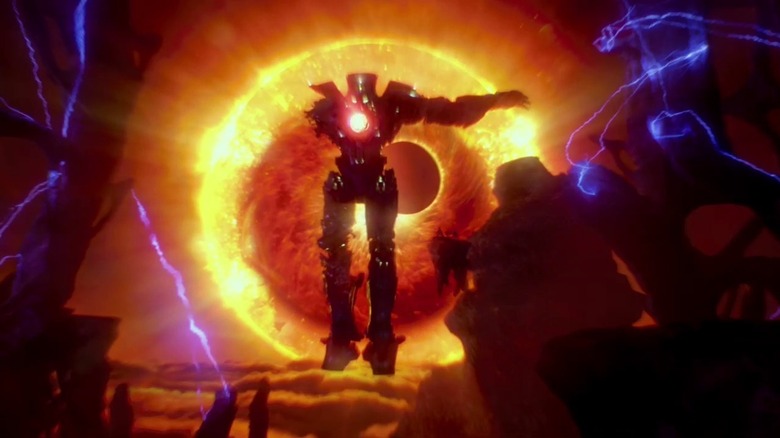Pacific Rim: 13 Facts About Del Toro's Hit That'll Help You Survive An Alien Invasion
Guillermo del Toro's career has included many incredibly thoughtful highlights, like "The Shape of Water" and "Pan's Labyrinth." Within these movies, del Toro utilizes the creatures and atmosphere we all associate with stories geared towards children or surface-level escapism and uses them to comment on the wider world around us. Within these heightened domains we catch glimpses of universal human behavior. "Pacific Rim" is not devoid of weightier thoughts or meaningful character beats, but it's proven to be such a beloved entry in del Toro's filmography because it's one of his lighter films. This is a motion picture about robots fighting big monsters and del Toro embraces all the innate silliness of this premise. Getting all wrapped up in the fantastical chaos doesn't produce a movie as weighty as "Water," but it does make for an incredibly fun watch.
Though more cynical viewers may dismiss it as something silly and frivolous, "Pacific Rim" was a production that required years of hard work and effort to exist. An assortment of facts about its creation and release reflect all that dedication. These facts cover everything from the thought process behind the design of the monsters to del Toro's evolving attitude towards "Pacific Rim" being shown in 3D, among many other elements. Exploring the deepest corners of these facts will only make fans appreciate the finer details of "Pacific Rim's" mayhem even more.
Classic disaster movies molded Pacific Rim
Usually, when an artist takes inspiration from classic blockbusters in making a new piece of big-budget cinema, it's to be reverent to the past. Think of how J.J. Abrams lovingly paid tribute to 1980s Amblin movies with "Super 8" or the way "Heat" influenced the filmmaking style of "The Dark Knight." But with "Pacific Rim," screenwriter Travis Beacham went in a different direction. Talking to Diabolique Magazine, Beacham noted that he looked at the norms of vintage American disaster movies... and then ran in the opposite direction of those traditions.
Beacham observed how in so many of those disaster movies, the events that happen in other countries are treated like an afterthought. Those places and their inhabitants aren't treated like human beings or dramatically compelling entities. This meant that he began writing "Pacific Rim" with the notion that the movie wouldn't set its massive action sequences in America. This choice also ensured that "Pacific Rim" wouldn't get enamored with just blowing up recognizable American landmarks, a cliché of iconic disaster movies. Guillermo del Toro would later hammer home, once he stepped in as director, that the story was about the world canceling the apocalypse rather than America rushing in to save everybody. With these qualities firmly rooted in mind, "Pacific Rim" was able to differentiate itself greatly from traditional disaster movies.
Travis Beacham and Guillermo del Toro got along as screenwriters
Though "Pacific Rim" is now firmly thought of as a Guillermo del Toro movie, the project didn't start its existence from the brain of this auteur. Instead, "Pacific Rim" emerged as an original concept from screenwriter Travis Beacham. This writer explained to Diabolique Magazine that when the film first started production del Toro's presence was a lot more fluid and uncertain since he had commitments to other movies to take care of. With del Toro not initially set as the movie's director, Beacham functioned as the primary creative voice in "Pacific Rim."
However, del Toro eventually zeroed in on "Pacific Rim" as a movie he'd direct, which is when he began to really collaborate with Beacham on the screenplay. Beacham recalled how the pair often had very different ideas on how to approach this universe, but they were always working towards the same thematic endpoint. That allowed for some common ground in their writing that ensured they'd get along swimmingly as screenwriting partners. Plus, there were some very important shared passions between the two screenwriters, such as their unified love for staging big robot and monster battles against darkened or rainy environments so that audiences could better understand the staggering sizes of these beasts. The writing process for "Pacific Rim," like in any movie, was not an easy one, but Beacham and del Toro proved to be a fine writing duo through every challenge and hurdle.
The timing of Pacific Rim was perfect for Guillermo del Toro's career
At the dawn of the 2010s, Guillermo del Toro was a few years removed from his 2006 directorial effort "Pan's Labyrinth," which rocketed him to a new level of critical acclaim and pop culture consciousness. Since then, this auteur had helmed "Hellboy II: The Golden Army" and had attempted to direct a pair of "Hobbit" movies, but the latter project fell apart in pre-production. Once "Hobbit" went nowhere, del Toro shifted gears to another passion project: a feature film adaptation of the H.P. Lovecraft story "At the Mountains of Madness." The production was a labor of love for del Toro, but that didn't help it win over studio executives.
Del Toro recalled to Collider how he was initially attached to "Pacific Rim" solely because of his commitment to "Madness." Just three days after "Madness" fell apart, del Toro stepped into "Pacific Rim" as its director, his prior intimate knowledge of the project making him a perfect candidate to shepherd it to completion. After two big passion projects fell apart, del Toro had an incredible level of determination to not only complete "Pacific Rim" but also to make it live up to all its creative potential. It's doubtful del Toro would've phoned in "Pacific Rim" if he'd made it in any other era of his career but making it at this specific point in his life imbued a unique sense of urgency to his filmmaking.
The look of Pacific Rim reflected Guillermo del Toro's favorite visual details
The works of Guillermo del Toro have an immediately distinguishable visual aesthetic. Just taking a frame from "The Devil's Backbone" or his "Pinocchio" movie will give off immediate signifiers that this feature belongs to del Toro. The director himself was joking about his go-to visual elements when talking to Collider about "Pacific Rim," with the filmmaker making snarky comments about how this big blockbuster would utilize del Toro's love for combining blue steel with amber.
Beyond just the surface-level colors, though, del Toro was also determined to make sure "Pacific Rim" lived up to his prior features by lending an immediate lived-in quality to this fictitious world. Rather than crafting the robots or the buildings to be incredibly sleek, he wanted the feature to evoke the environments of "Pan's Labyrinth" by being riddled with all the imperfections of reality. Of course, del Toro wasn't aiming to just repeat what had worked visually in his earlier works, as he was also hoping to take audiences by surprise with the unprecedented scope of "Pacific Rim," among other unique visual flourishes. However, by embracing those subtle demonstrations of wear and tear, "Pacific Rim" could both lend a sense of authenticity to its vision of a post-apocalyptic world and be consistent with the visual style audiences have come to know and love from del Toro's works.
Guillermo del Toro wanted Pacific Rim to be classical, not grim
At the time of the release of "Pacific Rim," there was a tendency towards making blockbusters that were darker rather than fantastical. Inspired by the likes of lucrative titles like "The Dark Knight," the American blockbuster scene had become dominated by expansive but downbeat titles. Exceptions existed in the landscape (such as the 2012 title "The Avengers") but the norm for big-budget films was to hew closer to the tone of Christopher Nolan movies than classic Steven Spielberg. When crafting "Pacific Rim," Guillermo del Toro was conscious of this rampant norm and was conscious of creating this robot/alien feature as something that could rebuke this standard.
Del Toro remarked to Den of Geek that, in the five years before the release of "Pacific Rim," most of the blockbusters that had come out were more concerned with existential matters and grim tones. By contrast, "Pacific Rim" was meant to emulate the streamlined and hopeful atmosphere of the blockbusters that had first gotten del Toro enamored with blockbuster cinema in the first place. Being unafraid of sentimentality and a sense of fun was critical to del Toro's vision of "Pacific Rim," with that vision eventually helping the feature stand out from the then-current default blockbuster aesthetic.
Pacific Rim was Guillermo del Toro's first digitally-shot movie
There were a lot of major firsts for Guillermo del Toro as a director when it came to "Pacific Rim." One of the most notable breakthroughs for del Toro on this feature was that it would be his first directorial effort shot with digital cameras rather than captured on 35mm film. In just a handful of years since del Toro's previous directorial effort, "Hellboy II: The Golden Army," digital projection and cameras had become far more common. With this ubiquity spurred on by movies like "Avatar," it was inevitable that del Toro would want to explore the possibilities of this new filmmaking style
Del Toro's go-to cinematographer, Guillermo Navarro, explained to IndieWire that one of the biggest hurdles of adjusting to digital shooting was how malleable the format is. Digital cinematography is easier to change in post-production, which meant that Navarro was concerned about keeping his and especially del Toro's visual sensibilities intact throughout every step of production. Despite this sort of unique problem, it seems going this route in terms of camerawork ended up pleasing Guillermo del Toro. The iconic filmmaker noted to MovieMaker in 2017 he'd grown quite fond of shooting movies digitally and credited this transition to the level of comfort he felt with using the technology on "Pacific Rim."
Guillermo del Toro was initially hesitant to convert Pacific Rim into 3D
As late as August 2012, Guillermo del Toro was passionately telling outlets like Collider that he didn't want "Pacific Rim" to be a movie shown in digital 3D. Though this medium was the norm for projecting blockbusters in a post-"Avatar" world, del Toro staunchly felt that the scale of the robots and monsters would be hurt by the presence of 3D. With that, it seemed to be a closed book on the idea of "Pacific Rim" being the next digital 3D juggernaut... until September 2012 rolled around. This is when Warner Bros. announced that "Pacific Rim" would hit movie theaters in digital 3D formats around the world.
Del Toro explained the decision to Shock Till You Drop (per Collider) that, since his initial comments about how 3D could ruin "Pacific Rim," he'd seen visual effects shows that addressed his concerns regarding scale. He also noted that he was further pleased with the idea of the post-production 3D process taking 40 weeks to complete, with the filmmaker promising to be involved every step of the way in overseeing quality control on this process. On top of everything else, "Pacific Rim" even got extra money to realize certain CG elements as 3D from the start. With all that in mind, it becomes much clearer why Guillermo del Toro had a change of heart and embraced "Pacific Rim" becoming a digital 3D movie.
Iconic filmmakers molded Pacific Rim in the editing room
We all need a little help from our friends sometimes. That's just as true for Guillermo del Toro as it is for any ordinary person. When it came time to work on post-production for "Pacific Rim," del Toro ended up getting some advice and aid from two of his filmmaking buddies, Alfonso Cuaron and Alejandro Gonzales Inarritu. The bond between these three gentlemen has become so famous in pop culture that the trio has even been given the nickname "The Three Amigos" in reference to their shared origins as directors from Mexico and the tight bond they share. That connection became very handy when it was time to edit "Pacific Rim."
Del Toro explained to Vulture that he's often turned to these two directors for help on some of his most acclaimed movies in the past, including when Inarritu helped trim "Pan's Labyrinth" down by 15 minutes. They once again helped shape "Pacific Rim" in the editing room, with Inarritu chopping out 10 minutes of the final product. Cuaron, meanwhile, was also helping to trim the fat of "Pacific Rim," but his primary advice to del Toro was with editing and specifically on the placement of certain shots in the movie's runtime. Friends can be so critical in helping us navigate the treacherous waves of life or even just the post-production process on a movie as big as "Pacific Rim."
The sets of Pacific Rim were massive
Considering its plot was focused on massive robots and alien monsters, it only makes sense that "Pacific Rim" would also utilize practical sets that were equally enormous. In a breakdown of the movie from Variety, it was noted that there were 101 sets built for "Pacific Rim," including ones built on top of real-world locations like the Lake Ontario beach. These sets accomplished a lot of remarkable functions, including accentuating the scale of the movie to the actors when they were on the set. The big evil monsters wouldn't exist until post-production, but the sets would immediately drive home just how massive this movie was.
Del Toro explained to Collider that he was always urging for as much of "Pacific Rim" to be realized through practical means as possible, hence why so many gargantuan sets were built for this blockbuster. He wanted there to be an immediate tangibility to this world and for its scale to be apparent even when there weren't gargantuan robots lingering in the frame. Of course, pursuing those ambitions meant dominating Pinewood Studios and every soundstage del Toro could get his hands on. But it was all worth it to ensure that the sets of "Pacific Rim" made this unbelievable world seem incredibly convincing.
The Pacific Rim monsters were designed to emulate people in suits
A video for Gizmodo breaking down all the thoughts that went into the making of the Kaiju in "Pacific Rim" reflects a lot of things, including Guillermo del Toro's enduring passion for unforgettable movie monsters. But this video also reveals a very important detail in the designs of these beasts. Specifically, del Toro revealed here that all the Kaiju in "Pacific Rim" are designed to reflect the idea that these beasts could be realized as men inside rubber suits, just like in classic monster movies. On paper, CGI can allow you to do practically anything, but del Toro was very conscious of keeping these monster designs grounded in classical terms.
This meant that the majority of the monsters in "Pacific Rim" would walk around on two legs rather than having an endless assortment of legs that would be impossible to properly realize with a man in a practical costume. Del Toro did stress that this inspiration didn't mean that the monsters were supposed to be humanoid in appearance, they were still created to be gnarly otherworldly creations. However, this critical design ensured that the various Kaiju in "Pacific Rim" was very much following in the footsteps of the classic movie monsters that del Toro had loved growing up.
The most draining part of shooting Pacific Rim was wearing the suits
There are countless ways "Pacific Rim" could've been a challenging acting exercise for the movie's actors. Just having to work off CGI monsters who wouldn't be added until later in post-production could've driven some performers mad. Trying to exude a sense of relatable humanity that audiences could've latched onto within such a gloriously ridiculous world must've also been a challenge. But the specific aspect of filming "Pacific Rim" that provided so much hardship for these performers turned out to be all the physical labor required to inhabit the sets reflecting the interiors of the Jaeger robots.
Within these domains, the human performers needed to convey the sensation that they were controlling massive robots telepathically and bonding with their co-stars. The cast of "Pacific Rim" explained to Variety that it was a nightmare to try and act within these environments, particularly while wearing the heavy suits their characters needed to pilot those big robots. Max Martini and Rob Kazinsky suffered the worst as the first actors to work on these sets. Their experience in these confines was so difficult that the suits and sets were modified afterward for the other actors to address complaints expressed by Martini and Kazinsky. There were a lot of hard parts to shooting "Pacific Rim," but mustering up all the energy required to work and act within those specific sets was especially draining.
How Charlie Day got involved in Pacific Rim
Charlie Day's filmography before 2013 did not seem to indicate that he would one day show up in a movie involving big robots and monsters. Day had certainly established himself as an actor of note up to that point, thanks both to his work in "It's Always Sunny in Philadelphia" and his leaping into hit feature films like "Horrible Bosses." But these were all low-key comedies rooted in some discernible reality. They didn't involve high-concept elements like aliens or automatons. Day would find himself in whole new territory as a performer, though, when it came time to play Newt, a scientist and Kaiju enthusiast who ends up being critical to the plot of "Pacific Rim."
It may seem like a strange detour in Day's career, but it was a role Guillermo del Toro was keen for this actor to inhabit. Day recalled to Collider how he got a call one day to meet up with del Toro at his office, which resulted in a meeting where del Toro not only professed his love for "Always Sunny" but also revealed that he wanted Day to play Newt. Day was entranced by the concept art and story details he was seeing about "Pacific Rim," but what really grabbed him about the project was working with del Toro. A filmmaker of that caliber was enough to push Day into exciting new territory as an actor.
The practical effects work for Pacific Rim was also intense
While "Pacific Rim" made extensive use of digital effects wizardry to bring to life its massive monsters and equally sizeable robots, this didn't mean more analog methods of visual effects were excluded from the feature's production. An Animation World Network profile from July 2013 outlined the wide variety of practical effects utilized for this modern blockbuster. A specific focal point for the practical effects in "Pacific Rim" were scenes where the movie's biggest beasts destroy significant locations like sports stadiums or buildings. Believe it or not, many of these sequences relied heavily on models and miniatures made by outfits like 32TEN Studios.
32TEN also delivered details like shattered glass or moving water that CGI elements in "Pacific Rim" could interact with. These and other moments in the film worked on by 32TEN Studios demonstrate a fascinating merging of various eras of visual effects mastery. Within this movie, practical effects were used to enhance the realism of creatures and battles that could only exist within a digital space. In the vast world of visual effects, there's plenty of room for both practical and digital tools. That's a truism that can often be forgotten in the world of modern cinema, but the filmmaking of "Pacific Rim" prospered by being fully conscious of how well the old and the new can work together.
The box office run of Pacific Rim was complicated
The scale of action sequences in "Pacific Rim" was mammoth, while its visual imagination was similarly staggering. Every aspect of "Pacific Rim" was just gigantic... except for its box office haul. Unfortunately, the feature didn't break out at the North American box office. In its domestic run, the movie only grossed $101.8 million on a $190 million budget. Among 2013 movies, "Pacific Rim" came in behind the likes of "Now You See Me," "Epic," and "Lee Daniels' The Butler" in North America, all of which cost significantly less to make. Trying to get moviegoers in this country enamored with an original sci-fi concept like this one, devoid of big movie stars or recognizable IP, just didn't work out.
However, "Pacific Rim" did make up some ground internationally, where it managed to gross just over $309 million, bringing the movie to a $411 million global haul. Much of this sum came from China, where "Pacific Rim" turned into a sizeable sleeper hit that cracked $100 million. Those box office feats weren't enough to turn "Pacific Rim" into a record-shattering moneymaker, but making up some ground overseas did ensure that it wasn't the next "John Carter" among sci-fi box office misfires. The box office run for "Pacific Rim" was ultimately fraught with enough problems to ensure that it could never be as big of a financial winner as the scope of its action sequences.
